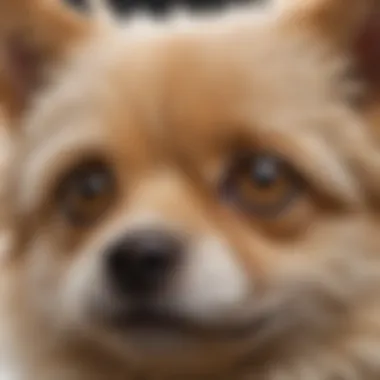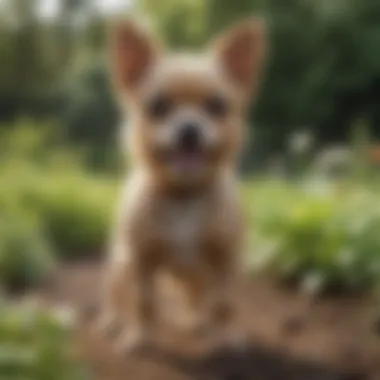Small Dogs That Shed Less: Discovering Low-Shedding Breeds


Intro
In the realm of dog ownership, the pursuit of a low-shedding companion is often a priority for many. Small dog breeds, in particular, have garnered attention due to their manageable size and lesser impact on household cleanliness. This article aims to provide an enlightening exploration of small dog breeds that are known for their minimized shedding, which can significantly ease the burden of allergens and pet hair in living spaces.
Understanding the unique grooming needs and health considerations of these breeds is essential for potential dog owners. Through a comprehensive analysis of distinct breeds, this article will shed light on their temperaments, maintenance requirements, and suitability as pets for various lifestyles. By considering these factors, individuals can make informed decisions on which low-shedding small dog may fit best into their homes and hearts.
Animal Profile
General Overview
Small dogs that shed less tend to possess non-shedding or low-shedding coats, thanks to unique biological traits. Breeds such as the Poodle and Bichon Frise have coats that are often compared to human hair, making them an attractive choice for allergy sufferers. These breeds usually do not leave piles of fur on furniture or clothing, providing a cleaner environment.
Habitat and Distribution
The adaptability of these small dog breeds allows them to thrive in various environments, from urban apartments to rural settings. Many of these breeds were initially developed for specific tasks, which influenced their geographical distribution. For instance, the Yorkshire Terrier has its roots in England, while the Shih Tzu originated in Tibet before being popularized worldwide. Owners should consider their own living situation when selecting a breed, taking into account space and lifestyle preferences.
Fascinating Facts
Unique Traits and Adaptations
Among small dog breeds, those that shed less commonly showcase distinct traits. For instance, the Maltese has a long, flowing coat that requires consistent grooming, yet it sheds very little. Another intriguing adaptation is found in the Schnauzer, which has a double coat that provides protection against various environmental factors.
Historical and Cultural Significance
Many low-shedding small dogs have historical significance, often associated with specific cultures or roles. The Chihuahua, for example, has Pre-Columbian roots in Mexico and is believed to be a descendant of the Techichi, a companion dog of ancient civilizations. These breeds not only serve as pets but also reflect a rich cultural heritage that owners may find meaningful.
Care Tips for Pet Owners
Basic Needs and Requirements
To ensure the well-being of low-shedding small dogs, understanding their basic needs is crucial. Regular grooming is essential to maintain their coats and skin health. Each breed may have unique dietary preferences, and a balanced diet tailored to their age and activity level is important.
Health and Wellness Tips
Preventative health care should not be overlooked. Regular veterinary check-ups, vaccinations, and parasite control are vital to a dog's overall health. Additionally, providing opportunities for physical activity and mental stimulation will enhance their quality of life and strengthen the bond between pet and owner.
Low-shedding dog breeds can offer an aesthetically pleasing and practical companionship, requiring dedicated care and attention to thrive.
By understanding the unique characteristics and needs of these small dog breeds, potential pet owners can make thoughtful choices that match their lifestyles, ensuring a harmonious and rewarding relationship.
Understanding Shedding in Dogs
Understanding shedding in dogs is an integral part of choosing the right pet, particularly for those considering small breeds. It informs potential dog owners about what to expect in terms of coat care and allergens within their homes. Shedding, while a natural process, can vary significantly between different breeds and individual dogs.
When dogs shed, they lose fur that can trigger allergies in sensitive individuals. This is an important aspect that many first-time pet owners might overlook. Additionally, recognizing the seasonal patterns of shedding can help in planning grooming routines and cleaning schedules.
What Causes Shedding?
Shedding is primarily a biological process triggered by factors such as changes in temperature, hormonal levels, and overall health. Natural cycles in a dog's life, like puppy growth and aging, also influence the amount of hair they lose. Other contributing factors include:
- Seasonal changes: Many dogs experience increased shedding in spring and fall as they transition between winter and summer coats.
- Health issues: Stress, poor nutrition, and skin conditions can lead to excessive shedding.
- Hormonal changes: Fluctuations during various life stages can impact a dog's coat.
The Role of Breed in Shedding
The breed of a dog plays a critical part in how much they will shed. Some breeds are known for their low-shedding coats, while others are notorious for heavy shedding. Low-shedding breeds tend to have hair rather than fur, which may not break off as easily. Here are a few examples:


- Poodles: Available in toy, miniature, and standard sizes, these dogs are well-regarded for their low-shedding coats.
- Bichon Frise: Their curly, soft coat traps hair, reducing the amount that ends up on furniture and floors.
- Maltese: Known for their long, silky hair, they also shed minimally compared to many other breeds.
Shedding Cycles and Patterns
Understanding the would-be shedding cycles helps owners anticipate periods of increased hair loss. Generally, most dogs follow a pattern based on:
- Age: Young puppies may shed their initial coat, while older dogs may shed more due to aging.
- Seasons: Many dogs shed their undercoat in preparation for summer heat and grow thicker fur in winter.
- Stressful events: Times of stress can lead to sudden increases in shedding, often seen in dogs adjusting to new environments.
In summary, shedding is not merely an inconvenience; it is tied closely to a dog's health, breed, and environment. Understanding these factors equips potential owners with the knowledge they need to maintain a harmonious relationship with their low-shedding small dog.
“Knowledge is power; it empowers pet owners to make informed decisions about the breed that matches their lifestyle.”
Benefits of Low-Shedding Dogs
Low-shedding dogs offer several benefits that can significantly enhance the quality of life for pet owners. With increasing awareness of allergies and the desire for cleaner living spaces, these breeds have become appealing choices for families, professionals, and other demographics. The following sections examine some key advantages of having low-shedding dogs, focusing on allergy considerations and the aspects of maintenance and cleanliness.
Allergy Considerations
Allergies can be a major concern for many individuals and families, particularly those who are sensitive to pet dander. Low-shedding dog breeds often produce fewer allergens compared to their higher-shedding counterparts. For example, breeds such as the Maltese or the Toy Poodle typically have hair that does not fall out as much and produces less dander. This characteristic makes it easier for individuals with allergies to coexist with these dogs, thus minimizing potential allergic reactions.
Research indicates that exposure to pets can either aggravate or reduce allergies, depending on individual circumstances. Routine grooming and cleaning can further diminish allergens in the home. Selecting low-shedding breeds serves as a practical strategy for families dealing with allergies. Moreover, many veterinary professionals and allergists recommend low-shedding dogs for allergic individuals due to their relatively hypoallergenic qualities.
Maintenance and Cleanliness
Low-shedding dogs require different maintenance levels than their shedding counterparts. While all dogs require grooming, low-shedding breeds typically need it less frequently. This benefit saves time and effort for pet owners. The absence of loose fur around the living area simplifies cleaning routines, resulting in a cleaner home environment. Vacuuming, dusting, and other clean-up operations become less labor-intensive.
When it comes to grooming, low-shedding breeds may still require proper tools to maintain their coats. Regular brushing helps to remove debris and prevents matting. It is advisable to use specific brushes designed for these breeds to create effective grooming routines. Beyond weekly brushing, occasional visits to professional groomers can also ensure that these dogs remain well-cared-for.
In summary, the benefits of owning low-shedding dogs encompass various aspects such as managing allergies and maintaining a cleaner living environment. By selecting a low-shedding breed, owners can enjoy companionship without the burdens often associated with dog ownership.
Small Dog Breeds That Shed Less
Small dog breeds that shed less hold significant value for many pet owners. These breeds offer not just minimal shedding, but often have hypoallergenic qualities, making them ideal for allergy sufferers. For individuals living in small spaces or those who prefer to maintain a clean home, low-shedding dogs present an attractive option. Moreover, understanding the care and temperament of these breeds can enrich the pet ownership experience, providing companionship while minimizing the challenges associated with grooming and cleaning. The following sections will delve into various small dog breeds recognized for their low-shedding characteristics, along with insights into their unique traits and care considerations.
Poodle Varieties
Poodles are among the most notable breeds associated with minimal shedding. Their unique coat requires regular grooming, but this also means they lose less fur around the house, which can be appealing.
Toy Poodle
The Toy Poodle is a standout in the realm of small dogs that shed less. One of its primary appeals is its compact size, making it fit for apartments and small living spaces. A key characteristic of the Toy Poodle is its curly, dense coat which requires frequent grooming. This keeps shedding to a minimum, making it a popular choice among those with allergies. Additionally, Toy Poodles are known for their intelligence and agility, offering both companionship and the ability to learn tricks easily.
However, potential owners should be mindful of their grooming needs, which can be seen as a disadvantage for some. Regular visits to the groomer may be necessary to maintain their coat and prevent matting.
Miniature Poodle
Similar to the Toy variety, the Miniature Poodle also boasts a low-shedding coat that is both aesthetically pleasing and practical. This breed maintains an excellent temperament, being friendly and adaptable. Its key characteristic is its versatility; Miniature Poodles thrive both in active households and quieter homes. They provide an excellent balance of playfulness and calm nature.
Grooming is essential for Miniature Poodles as well. Their coats require regular brushing to keep them in good condition and lessen the chances of shedding. However, their adaptability makes them suitable for various living situations, which furthers their desirability as pets.
Bichon Frise
The Bichon Frise is another small breed known for its low shedding. Characterized by its fluffy white coat, this dog requires consistent grooming to maintain its appearance. The Bichon’s coat is unique because it traps dead hair and dander, preventing it from becoming airborne. This trait is beneficial for allergy sufferers, making it a good candidate for families looking for companionship without the burden of excessive pet hair.
However, potential Bichon owners should consider the grooming time and expenses involved. Regular sessions are necessary to keep their fluffy coats looking their best and minimize any shedding.
Maltese


Maltese dogs are often celebrated for their beautiful, long, silky fur, yet they shed very little hair. Their coats require regular grooming, which can be seen as a positive, as it provides bonding opportunities. A noteworthy characteristic of the Maltese is its playful and affectionate nature. This breed easily forms strong attachments to its family members, often enjoying an active role in household activities.
While the grooming needs can be intense, the benefit of having a low-shedding companion outweighs them for many. The Maltese excels in providing emotional support as well, which many pet owners value highly.
Shih Tzu
The Shih Tzu is known for its distinct appearance and loving disposition. With a luxurious coat that requires regular grooming, Shih Tzus are relatively low shedders. Their key characteristic is a sweet temperament, often forming strong attachments to their owners. This breed enjoys being a part of family activities, making them great companions for both individuals and families.
Despite their grooming needs, which can be tedious, the Shih Tzu's gentle nature makes it a popular choice. Owners should be prepared for regular coat maintenance to enjoy the benefits of low shedding.
Yorkshire Terrier
Yorkshire Terriers are small but full of personality. Known for their long, flowing coat, they also shed very little hair. One main benefit of having a Yorkshire Terrier is their adaptability and loyalty. They excel in small living spaces and provide companionship without excessive grooming concerns, as their hair resembles human hair more than canine fur.
Like other breeds, regular grooming is essential to keep their coat healthy. Yet, their overall disposition and minimal shedding make Yorkies a cherished pet for many.
Italian Greyhound
Italian Greyhounds are elegant and graceful, with a short coat that contributes to their low-shedding status. This breed is notable for its affectionate and playful nature. Despite their regal appearance, they are often quite adaptable and form close bonds with their owners. Their low grooming needs are a plus, as a simple occasional brushing keeps their coat in good condition.
The main drawback could be their sensitivity to cold due to their short coats, requiring owners to consider special care during colder months. Yet, their overall appeal makes them a worthy companion.
Cairn Terrier
The Cairn Terrier is another breed that sheds minimally while being highly spirited. Its rough coat does require some grooming, but the shedding remains manageable. Cairn Terriers are both energetic and intelligent, making them excellent pets for active families. They enjoy play and companionship, thriving in social situations.
The grooming required helps to maintain their coat and decreases shedding, which can be a great advantage for homeowners who are concerned about cleanliness.
West Highland White Terrier
The West Highland White Terrier, or Westie, is characterized by its distinctive white coat. While they do require regular grooming to maintain their appearance, they shed relatively little throughout the year. Westies are friendly and lively, making them excellent companions for both individuals and families.
Potential owners should be aware that their grooming requirements are essential for keeping shedding at bay. However, their endearing personality and low-shedding nature make them a favorable choice in the realm of small dog breeds.
Character Traits of Low-Shedding Small Dogs
Understanding the character traits of low-shedding small dogs is vital for prospective dog owners. These traits influence how a dog interacts with its environment and family members. Knowing what to expect can help individuals make informed decisions on which breed aligns with their lifestyle. Low-shedding breeds often exhibit unique characteristics that are worth exploring.
Temperament and Behavior
Temperament varies widely among dog breeds, but low-shedding small dogs often share certain behavioral traits. Many of these breeds possess a friendly disposition, making them excellent companions. For instance, Poodles are known for their intelligence and playful nature. Bichon Frises tend to be cheerful and affectionate. Understanding these traits can help identify a suitable match for different families or individuals.
Behavior is equally crucial. Low-shedding dogs may adapt well to various living environments. Some are highly social, requiring regular interaction with humans and other pets. This social aspect is significant for potential owners, ensuring that the dog will fit well into a home with children, seniors, or other pets.
Trainability
Trainability is another key factor to consider. Low-shedding small dogs vary in how quickly they can learn commands and behaviors. Many of these breeds are intelligent and responsive. For example, Toy Poodles excel in obedience training due to their eagerness to please. On the other hand, breeds like the Shih Tzu may be more stubborn but can also learn effectively with proper training techniques.
The methods used to train these dogs can impact their behavior and overall happiness. Consistent training sessions, positive reinforcement, and socialization exercises should be part of the training regiment. This not only helps the dogs learn commands but also supports their emotional well-being.
Compatibility with Families
When it comes to family compatibility, low-shedding small dogs are often versatile. Many of these breeds thrive in family settings. Calm breeds like the Maltese can adapt to quieter households. On the contrary, more energetic breeds, like the Yorkshire Terrier, might require families who can match their activity levels. Ultimately, owners must assess their family dynamic to select a breed that complements it.
Low-shedding dogs also generally bond well with children. Their manageable size makes them suitable for kids, and they are often gentle and nurturing. However, supervision is still important to prevent any accidental injury to both the child and the dog. Additionally, low-shedding dogs are sometimes more suited for allergy sufferers within the family, as they produce less dander.


Grooming Requirements for Low-Shedding Dogs
Grooming low-shedding dogs involves more than just a routine of brushing and bathing. Understanding the specific grooming requirements is critical for maintaining the health and appearance of these breeds. Regular grooming not only keeps the fur looking neat but also supports the dog's overall well-being. Each small dog breed that sheds less often has unique grooming needs due to their particular coat types.
A good grooming routine can enhance the bond between the owner and the pet. Establishing a consistent schedule allows the dog to adapt to handling and enjoy the experience. Additionally, it is crucial to keep the skin in good condition, minimizing potential health issues and discomfort.
Brushing Techniques
Brushing is an essential part of the grooming process for low-shedding dogs. Depending on the breed, the frequency and type of brush used can vary significantly. For instance, dogs like the Poodle have a curly coat that traps dirt and debris, requiring regular brushing to prevent matting. Here are some effective techniques for brushing:
- Select the Right Brush: Choose a brush according to the coat type. Slicker brushes work well for long-haired breeds, while bristle brushes are better for short-haired breeds.
- Brush Gently but Thoroughly: Start at the head and work your way down to the tail. Ensuring to reach the undercoat is important, as it can mat easily.
- Brush Regularly: Aim for a brushing session at least once a week for most low-shedding breeds. Daily brushing may be necessary for those with longer coats.
Professional Grooming Needs
Many low-shedding dogs benefit from regular professional grooming. Professionals have the experience and tools to ensure that your pet is groomed properly. For breeds like the Bichon Frise or Maltese, professional grooming might include:
- Haircuts: Regular trims help maintain the shape and manageability of coats.
- De-shedding Treatments: Specialized tools can help remove loose fur and undercoat, which home tools may miss.
- Ear and Nail Care: Groomers can also handle ear cleaning and nail clipping, which are as important as coat care.
Investing in professional grooming can save time and improve the overall health of your dog. It is recommended to schedule grooming every four to six weeks, depending on the breed and specific needs.
Bathing and Skin Care
Bathing is another important aspect of grooming low-shedding dogs. Regular baths help keep both the fur and skin healthy. Here are key considerations for bathing:
- Frequency: Bathing should not occur too often as it can strip the natural oils from the coat. Generally, it's advisable to bathe every one to three months.
- Use the Right Products: Select a gentle, dog-specific shampoo. Some dogs may benefit from hypoallergenic or medicated shampoos.
- Skin Care: Pay attention to any skin irritation or allergies. Consult a veterinarian if any concerns arise.
Investing time in grooming not only benefits the appearance of your dog but also contributes to its overall health.
Health Considerations for Small Dogs
Understanding the health needs of small dogs is crucial for any potential or current pet owner. Small breeds often have unique health considerations compared to larger dogs. Recognizing these factors can enhance their quality of life, ensuring they thrive in a loving environment. This section covers common health issues faced by small breeds and outlines effective preventative care strategies.
Common Health Issues
Small dog breeds are particularly susceptible to certain health conditions. Awareness of these issues allows owners to monitor their pets more effectively. Here are several common health concerns found in small dogs:
- Dental Problems: Due to their small mouths, breeds like the Maltese and Shih Tzu often experience overcrowded teeth, leading to periodontal disease.
- Patellar Luxation: This condition involves dislocation of the kneecap and is quite common in small breeds such as the Yorkshire Terrier. It can lead to pain or difficulty in walking.
- Heart Disease: Small dogs are at an increased risk for heart conditions, notably mitral valve disease, especially as they age.
- Obesity: It’s crucial to manage their diet carefully, as small dogs can gain weight rapidly, leading to other health issues.
Ignoring these common health issues can lead to serious complications, so proactive care is essential.
Preventative Care
Preventative care is vital for ensuring the long-term health of small dogs. Here are some key practices:
- Regular Veterinary Check-ups: Schedule annual vet visits to catch potential health issues early. Annual dental cleanings are also crucial for maintaining oral health.
- Proper Nutrition: Choose a balanced diet suited for small dog breeds. This helps maintain a healthy weight and prevent obesity-related issues.
- Exercise: Engage your dog in regular exercise tailored to its energy levels and age. This is critical for physical and mental health.
- Grooming and Hygiene: Regular grooming is not just about looks; it can help detect skin conditions or lumps early. Bathing and brushing also protect against parasites and skin irritations.
Taking these considerations into account enables small dog owners to provide a healthier, more fulfilling life for their pets.
Closure
In summarizing the exploration of small dogs that shed less, it is pivotal to consider the multifaceted benefits that accompany choosing a low-shedding pet. These dogs not only reduce the burden of constant clean-up but also provide a favorable environment for allergy sufferers. Their minimal shedding characteristics can significantly enhance the quality of life for families and individuals who may be sensitive to pet dander.
Moreover, low-shedding breeds often require more attentive grooming practices. This ongoing commitment can foster a stronger bond between owner and pet, as grooming serves as a form of interactive care. Understanding the grooming requirements specific to each breed ensures that potential owners are well-prepared for the care routines needed, facilitating a harmonious living arrangement.
Additionally, the analysis of small dog breeds extends beyond shedding. The character traits, health considerations, and compatibility with various lifestyles demonstrate that pet ownership is an intricate decision. Selecting a low-shedding dog is not solely about aesthetics; it encompasses lifestyle suitability and personal preferences.
The discussion sheds light on unique breeds such as Poodles and Bichon Frises, which are recognized for their low-shedding nature. By highlighting these breeds, the article underscores the diversity available for those who seek a small canine companion.
Ultimately, informed choices lead to fulfilling experiences. Potential dog owners are better equipped to assess their personal needs against the qualities of low-shedding breeds. Such thoughtful consideration helps in achieving a balance between one's living conditions and the companionship that dogs offer.
"Choosing the right dog is a commitment, and understanding shedding is crucial in making an informed decision."
With a well-rounded understanding of small dogs that shed less, prospective owners are empowered to select a pet that aligns with their lifestyle and expectations. This process enriches the rewarding experience of dog ownership, ensuring both the pet and owner thrive together.















